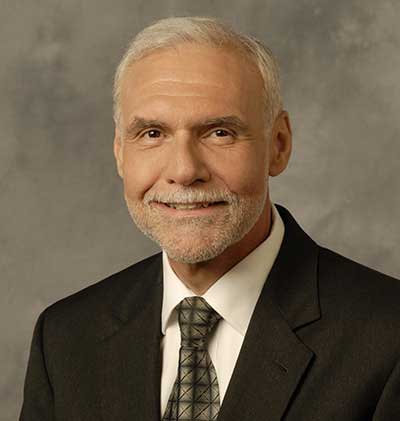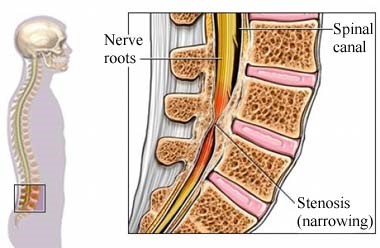
Carlos Palacio, MD at Coastal New Hampshire Neurosurgeons
Stenosis is the narrowing of any tube-like structure in the body. Spinal stenosis is a narrowing of the spinal canal. The spinal canal is located in the backbone. It is a small space that holds the nerve roots and spinal cord. If this space becomes smaller, it can squeeze the nerves and the spinal cord, causing pain and other symptoms. Stenosis can occur anywhere along the spinal cord, but is most common in the lower back (lumbar) region.
Spinal stenosis typically occurs in:
- The space at the center of the spine.
- Where nerves branch out from the spine to other areas of the body.
- The space between the bones of the spine.
Spinal stenosis has been described as a silent epidemic and, as the population ages, the number of people with this condition continues to increase. Lumbar spinal stenosis is the most common reason for surgery in people over the age of 60 in the United States, with almost half a million people in the United States suffering from lumbar spinal stenosis and many more experiencing cervical spinal stenosis.

Watch a video about spinal stenosis from the American Academy of Orthopaedic Surgeons.
What causes spinal stenosis?
Some people are born with narrowed spinal canals. Most often, though, stenosis is a result of aging. Other conditions that can cause spinal stenosis include:
- Osteoarthritis and osteophytes (bony spurs) associated with aging
- Rheumatoid arthritis
- Spinal tumors
- Trauma
- Paget's disease of the bone
- Previous surgery
Are there risk factors for developing spinal stenosis?
A risk factor is something that increases your chance of developing a certain disease or condition. Risk factors for spinal stenosis include:
- Age—Spinal stenosis is more common in people aged 50 years and older. Some researchers cite that up to 95% of the population has some spinal degeneration by the age of 50.
- Arthritis—Arthritis, the degeneration of a joint, is the most common cause of spinal stenosis.
- Congenital-Rarely, some people are born with a narrow spinal canal.
- Previous injury or surgery of the spine.
What are the symptoms of spinal stenosis?
Some people with spinal stenosis have no symptoms and may even be unaware of their condition.
Others may experience:
- Back pain
- Numbness, weakness, cramping, or pain in the legs and thighs
- Radiating pain in the buttocks and down the leg, also called sciatica
- Abnormal bowel and/or bladder function
- Decreased sensation in the feet causes a “foot slap” when walking and may result in a limp
- Loss of sexual function
- Partial or complete paralysis of legs
- Less pain when sitting or leaning forward, both of which create more space for nerves between vertebrae
How is it diagnosed?
You will be asked about your symptoms and medical history. A physical exam also will be done. Imaging tests that evaluate your spine and surrounding structures may include:
- Ultrasound
- X-ray
- Computed Tomography (CT) scan
- Magnetic Resonance Imaging (MRI) scan
How is it treated?
There are different treatment options for spinal stenosis, depending on the severity of the narrowed spinal canal. Nonsurgical treatments focus on relieving pain and restoring function to the spine. Surgical and Non-surgical treatments include:
Medication
Medications that relieve pain and inflammation include:
- Non-steroidal anti-inflammatory drugs (NSAIDs)
- Corticosteroid injections
Physical Therapy
Special exercises can help stabilize the spinal cord, and increase muscle endurance and mobility of the spine. Yoga and Tai Chi provide pain relief for some patients, though sometimes exercises are ineffective against spinal stenosis.
Support Devices
Wearing supportive devices, like a corset or lumbar brace, can help stabilize the spine and may relieve pain. Some patients also find it helpful to use a cane for added support.
Steroid Injections
ions near the nerves in the spine are used to decrease swelling and reduce pain. No more than three injections a year should be given.Acupuncture
Some patients find relief with acupuncture, which is considered a safe treatment, but long-term success is not yet known.
Chiropractic Manipulation
Chiropractic manipulation can help with some pain, but manipulation of the spine in those with osteoporosis or disk herniation can worsen spinal stenosis.
Surgery
Surgery is reserved for the most severe cases when the spinal stenosis causes nerve damage that affects bowel function and/or the ability to walk. Surgical options include:
- Decompression laminectomy—This procedure is the removal of bony spurs or a bone mass in the spinal canal. This can free up space for the nerves and the spinal cord.
- Spinal fusion—This procedure fuses 2 vertebrae (back bones) together in order to provide stronger support for the spine. This is almost always done after decompression laminectomy.
As with all surgeries, there is the potential for some complications. These may include:
- Dural Tear — tearing of the sac covering the nerves
- Failure of the bone fusion to heal
- Failure of screws or rods
- Nerve injury
- Need for further surgery
- Failure to relieve symptoms
- Return of symptoms
Is there a way to prevent spinal stenosis?
At this time, there are no guidelines for preventing spinal stenosis.
Sources:
American Academy of Orthopaedic Surgeons
Arthritis Foundation®
Spinalstenosis.org: